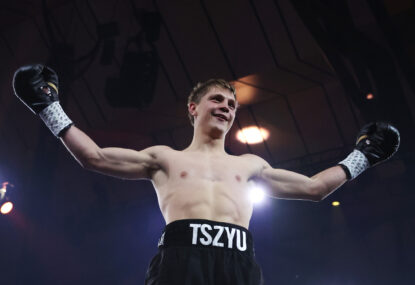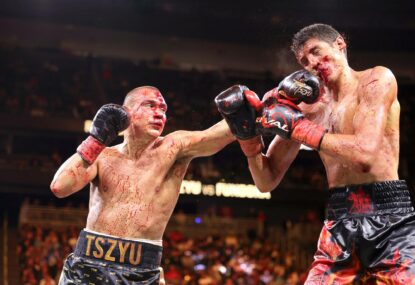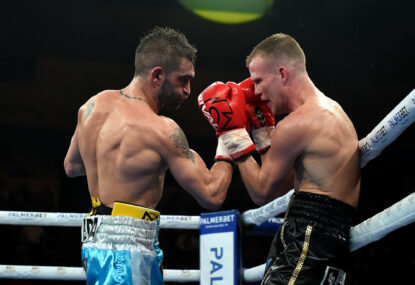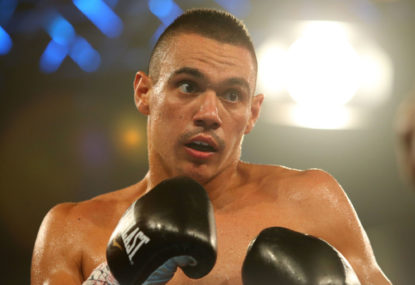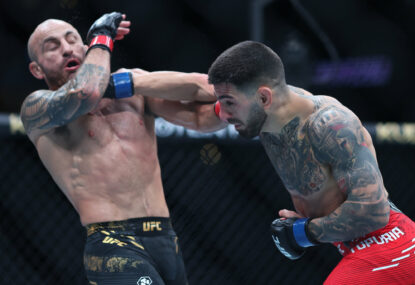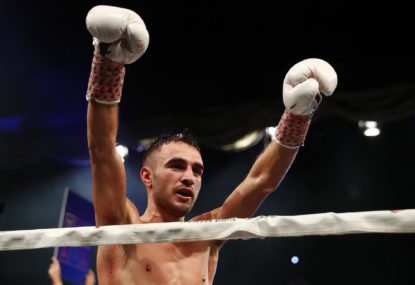Phil ‘Buzz’ Rothfield conservative diatribe was on display once again on Channel Seven’s Sunday Night, as the debate about Mixed Martial Arts (MMA) in Australia came to the fore.
In a bid for sensationalism there was a story on the MMA fights contested by children on Native American reservations in California outside of state regulations.
The footage was disturbing and at times unwatchable. US Senator John McCain once labelled UFC “human cockfighting”, and watching this episode of Sunday Night it was hard to disagree.
When interviewing UFC CEO Dana White, the carefully-worded question put to him was “how young should they start [MMA]?”. White, a former boxer and boxing trainer from the rough South Boston, answered as expected – that kids as young as eight and ten can spar. Indeed, he proudly bragged his own kids did.
None of this was surprising. Walk in to any Tae Kwon Do, Karate, Hapkido, Judo or Aikido dojo around the country and you will see this occurring. Sparring is not fighting. It is simulated fighting with limited contact and protective gear to teach the mechanics in a safe environment.
Had White been asked did he believe children as young as eight should be involved in full contact fights in front of crowds, I wager his disgust would be the same as Phil Rothfield’s. He is, after all, as famous for his passion for fighting as he is a doting father.
Although that the UFC is the biggest promotion in MMA by a wide margin, it does not control MMA practices anymore than the NRL can control impromptu playground rugby league games. The practices of watching eight-year-olds fight for the masses is ridiculous, and hence why they have to fight on Native American reservations. This is far removed from elite adult athletes contesting under the watchful eyes of the Nevada State Athletic Commission.
This all gets a bit exhausting. Whether Buzz likes it or not, he is going to have to get used to it, because MMA and its largest promotion – the Ultimate Fighting Championship (UFC) – is here to stay. It is the fastest-growing sport on the planet.
Lost on the detractors are the subtleties of the sport: the tactical battle planning of world class athletes trained in multiple disciplines of grappling, wrestling, striking and the defending and countering in a three-round, 15-minute sprint for glory. The countless ways each fighter can impose his will makes for a game theorist’s Valhalla.
Ever the outspoken maverick, Dana White will loudly complain that negative comments against his sport are just as applicable to boxing and other contact sports, such as football. He proudly claims that fighting is in our DNA and will be the first and last sport ever.
Although the UFC is only 20 years old, MMA is hardly a new concept. Boxing, wrestling and pankration (a combination of both) were contested in the Ancient Greek Olympics as early as 708 BC. The two highest-paid sportsmen in the world, Flloyd Mayweather and Manny Pacquio, are boxers. There is no doubt that a large proportion of the species enjoys watching people fight.
Blood in hair, spattered over bare chests, crimson droplets sprayed and smeared across the sky blue floor of the ring at times amplifies the macabre aspect of the sport. As a highly respected rugby league commentator, it is strange that Rothfield showed contempt for such inappropriate display of blood.
This commentary is hypocritical at best. Anyone who has watched State of Origin over the years will have seen blood spattered on sky blue to the delight of Queenslanders around the country. Shoulder charges and brutal gang tackles and collisions in league – a sport that proudly claims to be the toughest in the world – are as violent, if not more so, than anything to be witnessed in an octogon.
For the generation that has grown up with UFC, the arguments against the new sport are perplexing, because to them MMA is just part of the sporting landscape.
Despite meteoric emergence into the mainstream, Sunday Night continued to liken the barbarity of MMA to dogfighting and condescendingly compared the sport to Ancient Roman colosseums – while ironically, the iconic image of the NRL, of Norm Provan and Arthur Summons, is titled “Gladiators” .
The vitriol of blood being smeared over faces and chests as being inappropriate for modern society also comes from the same pens that write reverently of Ray Price, Wally Lewis, Arthur Beetson and Benny Elias; men who have seen more blood in a football game than middle weight champion Chris Wiedman has in his entire MMA career.
Rugby league is not alone in this barbarity. Geelong versus Hawthorne 1989 grand final had Dermott Brereton coughing up blood from a punctured lung, rugby union showed its own hand when Wallaby gold was sprayed liberally with crimson during the play-off for the World Cup bronze medal against Wales in 2011.
Sunday Night highlighted the graphic leg break Anderson Silva suffered in his second fight with Chris Wiedman as another poor example of the sport’s legitimacy. Where arguments about graphic spilling of blood seemed to hold water from the sporting community – this one dissolves completely. Broken noses, arms, legs and ligament tears are significantly higher in collision sports like rugby league, union and AFL (and let’s not even mention motorcycle racing).
The sheer physics of athletes running into each other at full speed cannot be generated in the confines of a octagon. When you consider that Nathan Hindmarsh could put himself through this over 50 times in an 80 minute period, every weekend for an entire season, to the delight of sports enthusiasts, it begs for a more egalitarian look at the contact aspects of MMA.
Mark ‘Super Samoan’ Hunt versus Antonio ‘Bigfoot’ Silva, December 7 last year, UFC Fight Night 33 at Brisbane Entertainment Centre was what ignited the debate in Australia recently. The headline act of Sydney-based Hunt and Brazilian behemoth Silva was a a spectacle in every sense and showcased the aspects of the sport that fire up such debates.
Both men weighed at the top range for heavyweights (close to 140 kgs) and they put on a performance that Dana White called the “greatest heavyweight fight” in the history of the sport. In the fifth round, both men, exhausted and battered, continued to try and finish each other.
Depending on your viewpoint it was one of the most amazing sporting contests or the most distasteful. The heart and skill on display was jaw dropping. The barbarity was undeniable. I felt like I was watching Origin in the 80s. The crowd and fans around the world roared their approval. As the UFC is valued between $3.5 and 4 billion and growing, it’s clearly doing something right.
The UFC have made no secret of the fact they are eagerly looking to continue to grow in the Australian market. UFC 110 was the inaugural show in Australia and was the fastest-selling gate in the promotion’s history. Australians are a people, much like their New Zealand and Canadian counterparts, that thrive on the loosely contained mayhem that is contact sports. Walk into any pub in any suburb in Sydney that screens UFC Main Event pay per views on a Sunday afternoon and you will find yourself waiting in line for a beer.
With the debate reignited, the UFC and its stable of fighters have responded the best way they know how – by serving up a contest that even the cynics could not deny accolades.
Once in a while you are lucky enough as a sports fan to watch a performance of an athlete or team that truly astounds you. Be it Matthew Mitchum hitting a perfect dive in an Olympic final, Kieran Perkins throwing down in Atlanta and unexpectedly taking a second 1500 metre gold home, or the Socceroos taking down the English at Wembley 3-1 I’m 2003. Some sporting moments transcend sport itself as the impossible becomes possible.
The fight between pound-for-pound kingpin Renan Barao (34-1) and TJ Dillashaw (10 -2) in Las Vegas was the occasion. This is a fight that Barao could have phoned in – Dillashaw, ranked number five, was consideried a solid top ten prospect but was essentially a nobody in the MMA world; just another statistic in over his head. He wasn’t even in the roster of the EA Sports UFC computer game to be released later this year.
His mentor at Team Alpha male, Urijah Faber, had been dominated for the second time in Barao’s last outing in the octogon so thoroughly that commentators were openly wondering whether Dillashaw would even keep the fight competitive. It was going to be a one-sided affair.
No one told TJ Dillashaw which side.
Like Bob Beamon in Mexico City in 1968, Dillashaw gave us one of those performances that has guaranteed him immortality in sport. He is one of the very rare breeds of athletes whose performance increases when the stakes get higher.
At the MGM Grand in Las Vegas, fighting the number one fighter for the bantamweight, Dillashaw looked like a veteran of championship fights from the outset. Loose and relaxed, the wrestler took on the best striker in the UFC at his own game. He stayed fluid, shifting stances like Zab Judah, working angles like Daniel Geale and moving up and down levels always threatening the expected wrestler’s takedown.
Barao cooly stalked his agitator, confident of his ability to finish him like the 34 before. Dillashaw’s courage and tenacity willed his fists to find their mark.
At the end of the first round, the nobody stunned the champion with an overhand right knocking him almost out of the state of Nevada. The crowd roared in disbelief as Dillashaw blazed away with brutal ground and pound.
Barao survived the round but was clearly hurt. Fight fans mused around the world this one round was an anomaly, and in the next four Barao would bring balance back to the universe. How wrong we were.
In the next three rounds, the impossible became the unbelievable as Barao wilted under the perpetual onslaught of the superbly conditioned Dillashaw.
At the end of the fourth the champion looked like Mike Gatting after Shane Warne’s ball of the century – as though someone had stolen his lunch. He heard the dreaded words from his corner “you are going to have to submit him or knock him out”.
Not satisfied with an unbelievable points domination, Dillashaw stepped up the pace and stood in the pocket with the desperate and still very dangerous champion, punctuating the performance with a spectacular finish – a head kick from his left leg.
Colour commentator Joe Rogan was stunned, calling it “the most amazing performance I have seen in mixed martial arts”. Commentators have been calling this an upset to rival Buster Douglas knocking out ‘Iron’ Mike Tyson in Japan in 1990.
However this was not a lucky punch, or a come-from-behind Rocky story, but a 25 minute athletic demolition of the man considered the best fighter in the world.
There were tears from Dillashaw’s cornermen and a defiant post-fight speech from the new champion that spoke of a man who never listened to the doubters and believed he could reach his dreams. In the most unforgiving of arenas, his dreams came true.
That is the very essence of why I love sport – any sport.





























































































